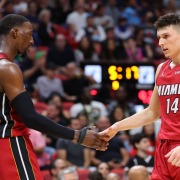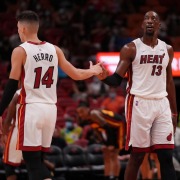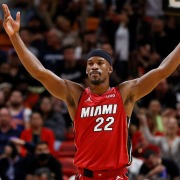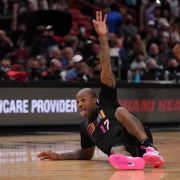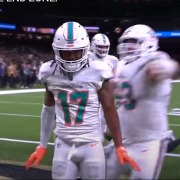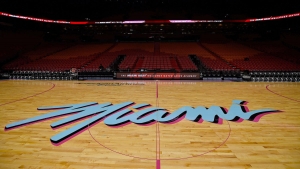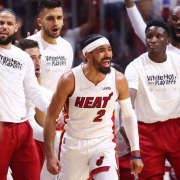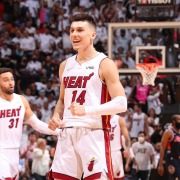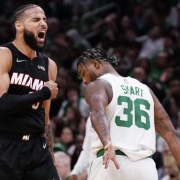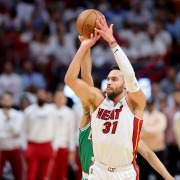The Miami Heat sport names long associated with the franchise. Udonis Haslem announced this offseason he’s returning for his 20th NBA season, all in Miami. Franchise cornerstones Dwayne Wade (15) and Alonzo Mourning (11) each spent more than a decade donning their Heat uniform. Guys like Keith Askins, who joined the team in 1990, and many others spent time as both a player and a coach in Miami. These players hold many of the single-season and all-time records in Heat history.
But those lengthy runs with the team aren’t the norm. At this point, only 16 players have spent more than five years with the Heat.
Over 35 seasons, the Heat have seen 274 players play at least one regular season minute for the franchise, with 153 of those spending no more than one year in Miami. But while the vast majority of those one-and-done players in did little of note, several stand out the annuls of Heat history.
Here’s a look at the Top 5 single-season performers in Miami Heat history.
Heat History Single-Season Player #5: P.J. Tucker, 2021-22
The Miami Heat signed P.J. Tucker to a two-year, $15 million deal last offseason following the forward winning an NBA Championship with the Milwaukee Bucks. Tucker looked like a seamless fit with the Heat, a player who provided defensive acumen and sniping ability from the corner three.
It was anticipated Tucker would split time at power forward with another one-year Heat player, Markieff Morris. However, the 36-year-old quickly assumed an integral space in Miami’s rotation and seemed to embody Heat culture faster than any other previous free agent addition.
Tucker helped Miami’s unlikely run to the Eastern Conference’s top seed heading into the playoffs and played a pivotal role for a team that finished mere minutes short of the NBA Finals. He averaged 7.6 points-per-game, the fourth-high output of his 11-year career, and netted a career-best 41.5 percent from three. He finished with a 11.3 Player Efficiency Rating (PER) and registered 5.0 Win Shares, fourth-most on the team.
Tucker played 71 regular season games and in all 18 playoff contests, though he was hobbled by the Eastern Conference Finals and wasn’t on the floor in the end. Tucker provided Miami with toughness and leadership through his single-season run, a notable one in Heat history.
While the Heat wanted Tucker to return, Miami wasn’t willing to use the $10.5 million non-taxpayer midlevel exception to re-sign him. Had they done so, the Heat would’ve been hard-capped, robbing them of financial flexibility to improve the roster down the line. Tucker declined a $7.4 million player option to test free agency and ultimately landed a three-year, $33.2 million deal with the Philadelphia 76ers.
PrizePicks is the easiest, fastest, and most exciting way to play daily fantasy sports!
PrizePicks is daily fantasy made easy. It’s just you against the numbers. Members predict the over or the under on between 2 and 5 player props of their choice. The more picks they correctly predict, the more money they win! Payouts on PrizePicks can be as high as 10X – 15X.
Use promo code: FIVE at signup for a deposit match up to $100!
Heat History Single-Season Player #4: Rex Chapman, 1995-96
Miami’s 1995-96 roster stands out as one of the most unique single-season squads in Heat history. 22 players suited up for the Heat that year, most in one year in franchise history at that point.
During the 1995 NBA Draft, Miami traded the rights to Ed Stokes and Jeff Webster to Washington for veteran shooting guard Rex Chapman and the Bullets’ second-round selection, guard Terrence Rencher. This turned out to be the last trade prior to Pat Riley joining the organization in September.
When Riley assumed leadership as head coach and team president, he kept Chapman on, releasing other holdovers like Brad Lohaus and Ledell Eackles. For the Heat, Chapman proved to be a buy-low investment that paid immediate dividends as Riley reshaped the roster around Alonzo Mourning.
Chapman played 56 games that season, starting 50 of them, and averaged 33.3 minutes-per-game. He averaged 14 points-per-game and made 37.1 percent of his attempts from three. He netted 125 threes that season, the fifth-highest single-season figure in Heat history at the time. (The top four at that point all came from Glen Rice.) He finished with 13.0 PER and 4.2 Wins Shares, fourth-most on the team.
Chapman lands on this list largely thanks to arguably the greatest single-game shooting performance in Heat history. On February 23, 1996, the Heat faced Michael Jordan and the Chicago Bulls, who were 48-6 at the time. Chapman was one of only eight players on the active roster for Miami that night following a flurry of trade activity involving a then-record 10 players.
Against the Bulls, Chapman scored 39 points, making 9-of-10 three-point tries during a time in the NBA when that many attempts were hardly the norm. Chapman helped spur the 113-104 upset, one of only 10 regular season losses for the Bulls that season.
His nine threes still register as tied for the second-highest single-game total in Heat history. And the 9-for-10 shooting performance is tied for the best ever (Dan Majerle went 9-for-10 from three in Minnesota on January 11, 2000) on that volume. Chapman came up one three short of Brian Shaw’s team-record 10, a mark Shaw set with a 10-for-15 night on April 4, 1993.
Following his productive season, Chapman expected better treatment from the Heat in free agency. Chapman sought a multi-year deal, but felt blindsided after Riley offered a one-year deal and a multi-year one with a minimal base salary loaded with incentives. Injuries limited Chapman that season and he ultimately took a minimum deal in Phoenix, choosing the Suns over offers from Indiana and Milwaukee because of lifestyle and playing time opportunities.
The Heat replaced Chapman for the 1996-97 by signing Dan Majerle and giving the bulk of the shooting guard minutes to two second-year players, Sasha Danilovic (before trading him to Dallas with Martin Müürsepp and Kurt Thomas for Jamal Mashburn) and Voshon Lenard.
Don’t Forget Tony Smith!
Tony Smith also provided the Heat with a notable performance that night. Smith, another single-season player in Heat history, was acquired via trade the day before, coming from Phoenix for Rencher.
Smith was cleared to play and arrived about 13 hours before tip-off that night. He started the game, scoring 19 points, and was asked to guard Jordan for much of the night.
Heat History Single-Season Player #3: Anthony Mason, 2000-01
Following another crushing playoff loss to the New York Knicks, Riley shook up the roster with a major trade in 2000. Miami and the Charlotte Hornets struck a nine-player deal swapping Jamal Mashburn, P.J. Brown, Otis Thorpe, Tim James, and Rodney Buford for Eddie Jones, Anthony Mason, Dale Ellis, and Ricky Davis.
Riley saw Mason as the ideal role player for a contender, having coached him before in New York. Mason blossomed under Riley after bouncing around the NBA and overseas, winning Sixth Man of the Year in 1995. He brought his toughness and skill to Miami, envisioned as a backup. But Mourning’s kidney ailment forced Zo out and made Mason a starter.
Mason quickly became a focal point for a 50-win squad. He averaged 16.1 points, 9.6 rebounds, and 3.1 assists-per-game that season, registering a PER of 17.4. He led the team with 11.6 Wins Shares and earned the lone All-Star berth of his career.
Mason still holds single-season records in Heat history for Minutes Played (3,254) and Minutes-Per-Game (40.7). He’s also tied for first in single-season Defensive Wins Shares (5.6). Mason’s 601 Defensive Rebounds are fifth-highest one year total. His 770 Total Rebounds are eighth-most. His Defensive Rating that season (97.5) remains the ninth-best for a single-season.
That production might engender a higher spot on this list, but Mason’s failings in the playoffs that season knock him down a peg or two. The Heat started slowly that season, going 5-9, but finished 45-23 from there, earning the 6-seed. But Mason basically disappeared during Miami’s first-round matchup against the Mashburn-led Hornets. He took only 13 shots, averaging just 5.3 points and three rebounds-per-game, during the three-game sweep.
Following the disappointing finish in 2001, the Heat opted to cut payroll. Mason, a free agent that summer, wanted a long-term contract, something the Heat weren’t willing to give the then-34-year-old. Mason ultimately signed a four-year, $20 million deal with the Milwaukee Bucks and the Heat pivoted closer to the rebuild that would land them Dwyane Wade in the 2003 NBA Draft.
Heat History Single-Season Player #2: Damon Jones, 2004-05
2004-05 holds one of the biggest single-season what-ifs in Heat history. What if Wade doesn’t suffer a strained rib muscle in the Eastern Conference Finals? With Wade, Shaquille O’Neal, Udonis Haslem and veteran role players, the Heat had high expectations and likely win the franchise’s first NBA title that season had Wade not been hurt.
To supplement the roster and move Wade to his more natural shooting guard position, Miami signed both Keyon Dooling and Damon Jones to man the point. To that point in his career, Jones was a journeyman, playing for eight teams in six seasons. He was an afterthought in free agency but proved to be a perfect fit with Shaq and Wade, and provided the best statistical season of his career.
Jones set career-highs almost across the board, averaging 11.6 points-per-game. He managed a 15.5 PER, which was fifth-best amongst Heat regulars that season, and 8.7 Wins Shares, fourth-most.
His 225 three-pointers made set a new franchise record at the time, breaking Tim Hardaway’s previous mark of 203 from 1996-97 (and at the time, tied with Mitch Richmond for the ninth most ever in an NBA season). Jones’ 43.2 percent clip from three finished fifth in the league that year and was third-highest in Heat history at the time (trailing only Jon Sundvold).
Jones set new franchise marks that have since been surpassed in True Shooting percentage (62.5), Effective Field Goal percentage (61.1) and Offensive Rating (124.1). Two of those figures rank third-highest for a single-season in Heat history, with True Shooting now seventh.
That ’04-05 team posted the second-best record in franchise history (59-23, now third-best) and made it to Game 7 of the Eastern Conference Finals.
Jones, then 29, entered free agency that summer looking for the first multi-year deal of his career. It appeared like he might re-sign in Miami after Michael Finley passed on the Heat, but Cleveland offered a longer and more lucrative deal (four years, $16.1 million) to play alongside LeBron James.
The loss of Jones and Dooling to free agency helped pave the way for Miami’s next big move, though. In what’s still the biggest trade in NBA history, the Heat landed James Posey, Antoine Walker, and Jason Williams that offseason. Miami also signed veteran point guard Gary Payton in free agency.
Heat History Single-Season Player #1: Lamar Odom, 2003-04
Riley long coveted Lamar Odom, dating back to the 1999 NBA Draft when the Heat secretly brought in Odom for a workout despite their first-round pick being slotted at No. 25. But any trade in the draft’s Top 3 picks at that time would have cost Miami core players like P.J. Brown, Jamal Mashburn, or even Tim Hardaway. The Heat stood pat and selected Miami native and University of Miami alum Tim James, who proved to be a draft bust.
Riley finally landed Odom in 2003 with a compelling free agency gambit. Riley first signed Clippers forward Elton Brand to a six-year, $82.2 million offer sheet, one Los Angeles matched. But in short order, the Heat inked Odom to six-year, $65 million offer sheet. The Clippers ultimately declined, in part, because of the financial commitment to Brand and Odom’s difficulties off the court. (Odom was coming off his second drug-related suspension.)
But Odom went on to produce one of the best seasons of his career. He averaged 17.1 points, 9.7 rebounds, and 4.1 assists-per-game playing 37.5 minutes-per-game for the Heat. He posted an 18.5 PER that season to lead Miami and ranked second with 8.4 Win Shares.
His production remained steady in the postseason as a very young Miami team, featuring a rookie Dwyane Wade at point. They made an unlikely run to the second round after starting the season 0-7.
Odom’s 616 defensive rebounds were the second-most in Heat history at that point and remain the fourth-highest single-season mark. His 776 total rebounds rank seventh-most. And while the plan was never to have Odom as one of these one-year wonders, his production allowed Riley to make him the centerpiece in the trade package that landed Miami Shaq.
During the 2004 offseason, Odom, along with Caron Butler, Brian Grant, a 2006 first-round pick (which became Jordan Farmar) and a 2007 2nd round draft pick, went to the Lakers in exchange for O’Neal.
Years later, Odom almost returned to the Heat. As a free agent in 2009, after winning his first NBA title with the Lakers a season prior, Odom seriously considered a five-year, $34 million offer from the Heat. In the end, Odom returned to Los Angeles and helped the Lakers win their second-straight championship.
Honorable Mention: Rod Strickland, 2001-02
The Heat signed Rod Strickland just a week before season’s tipoff in late October of 2001, presumably to help fill the void left following the team trading now Hall of Fame guard Tim Hardaway to the Dallas Mavericks earlier that offseason. Miami went with Strickland ahead of other veteran free agents at the time. Among those were one-time Heat guard Sherman Douglas, as well as Robert Pack.
The signing of Strickland, who was 35 years old at the time, came as a surprise. Riley seemed dedicated to a younger roster, including then third-year point guard Anthony Carter. Miami made a play for Strickland during the prior season, thinking they had an agreement with the veteran in March of 2001. But Strickland opted for a deal with the Portland Trail Blazers instead.
That season the Heat stumbled out of the blocks, going 3-15 through the first 18 games, including a 12-game losing skid. Carter started each of those contests. But Riley shook up the starting lineup in early December, adding Strickland to the mix. Miami sputtered through the end of December. It bottomed out at 5-23 on December 30th, but from there, the Heat went 31-23 the rest of the way.
Miami ultimately missed the playoffs that season by six games despite being one of the East’s best teams in the second half. Strickland provided a spark, averaging 10.4 points and 6.1 assists-per-game. He finished third on the team in Win Shares that season (4.9) and third in PER (15.6).
Strickland provided the Heat with the best production from the string of one-year veteran point guards that passed through Miami, a list that includes Travis Best, John Crotty, Keyon Dooling, Erick Murdock, and Terry Porter.

